Kentucky Fried Zero: Act 2 – English Edition
This is the second part of our analysis of Kentucky Route Zero.
Original by Magnus Hildebrandt, translation by Dennis Kogel
Deutsche Versionen: Teil 1, Teil 2, Teil 3
English versions: part 1, part 2, part 3
Welcome back, welcome back, I hope you thoroughly enjoyed the short break, had some lively small talk and tried some of our criminally overprized canapés. But break’s over, so please head back to your seats, because the second act of Kentucky Route Zero is about to start.
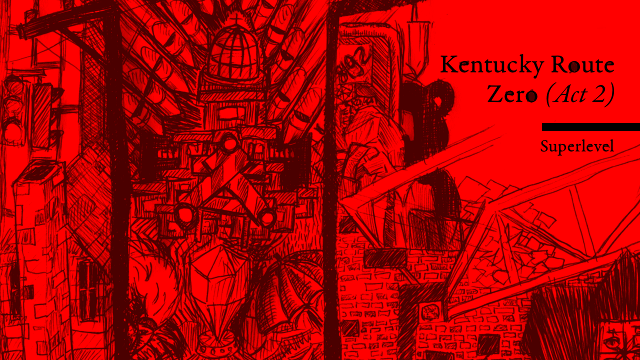
If you read the first part of this series, you know what you’re in for: I will examine the literary, cultural and artistic works that have influenced Kentucky Route Zero’s new episode. And, like in my last article, we’ll go deep into spoiler territory.
Occupy Church
Act Two begins in media res. Lula Chamberlain, the creator of the fictional “Limits and Demonstrations” exhibit from the eponymous bonus episode, works at the “Bureau of Reclaimed Spaces,” a government agency that repurposes empty lots and buildings. This, already, establishes one of the main themes of this episode: How shifts in the economy impact land owners and the traces they leave behind. It is a theme that is even apparent in the office space of the Bureau itself, a surreal looking cleaned out church, complete with an organ occupied by an Occupy-Organ-occupier.
The Bureau’s church is modelled after two existent churches: The Scottish St.Bride’s Church, East Kilbride, which provides the brick ornaments, and Gottfried Böhm’s pilgrimage church Mariendom in Neviges, near Düsseldorf.

Böhm’s church, a 20th century architectural icon, was built in the late 1960s in the wake of the modernization of the Roman Catholic Church after the Second Vatican Council. The Mariendom plays with concepts of inside and outside. Just take the street lamps. They illuminate the building from outside but are also placed inside the church. Kentucky Route Zero, too, poses questions about “inside-ness” and “outside-ness” time and time again – but I’m getting ahead of myself.
Let’s go back to St. Bride’s Church, East Kilbride. It is widely recognized as one of the most beautiful buildings of Scottish Brutalism – though, arguably, there’s not much competition on that front. St. Bride’s Church was developed by architects “Gillespie, Kidd and Coia”, a company that is responsible for most of the modern post-WWII churches in Scotland.
You can find references to the architects of both of these churches in the names of Lula Chamberlain’s co-workers: Böhm, Metzstein and MacMillian.
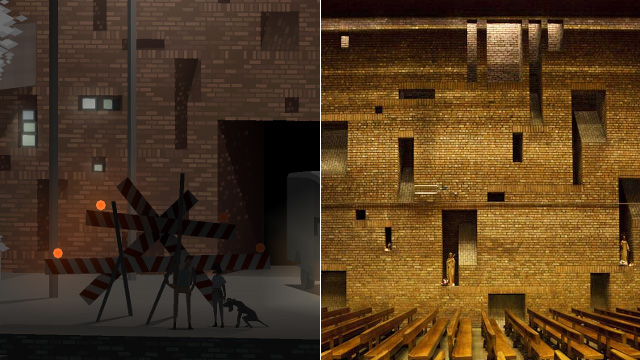
Dreamifying Spaces
In this episode’s intro sequence, Lula Chamberlain receives a letter of rejection from the “Gaston Trust for Imaginary Architecture.” This is a reference to the French philosopher Gaston Bachelard and his work “The Poetics of Space (La Poétique de l’Espace)” from 1958.
In his work, Bachelard deals with both the scientific and the imaginary, two very different, but, according to Bachelard, equally important parts of human expression. In “The Poetics of Space” he examines how architecture can influence the creativity of poets. This proved to be a huge influence on artists like
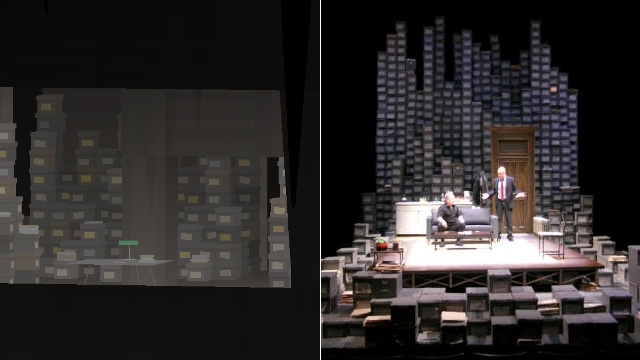
With their imagery of sea shells, nests and caves, the video installations in the “Bureau of Reclaimed Spaces” are basically a list of Bachelard’s examples of intimate spaces. According to Bachelard, the sea shell (a theme that is repeated when the protagonists find hermit crabs using office supplies as their shells) is the foundation for the concept of home, a clear division between inside and outside. This lets us circle back to the beginning of the episode when the protagonists ask whether they are outside or inside the Bureau. Bachelard devotes an entire chapter to a similar question. Although he considers the home to be a space of dreams that fuels the creative work of an artist, a work that can only be created in seclusion from the outer world, Bachelard argues to abandon the strict separation of inside and outside. It’s an idea that Kentucky Route Zero picks up whenever it blends dreams and reality, art and video games.
SHANNON: “Is this place inside or outside?“
The Great Depression
Somewhat later in this episode, we visit the “Museum of Dwellings”, which also plays with concepts of inside and outside. Inside, the Museum puts houses on display thus further referencing “The Poetic of Space”.
But there, we also encounter a source of reference that was used in the first episode: It’s the documentation of the Farm Security Agency (FSA). The Agency was established as a part of Roosevelt’s New Deal to reform the country after the Great Depression. The names of the museum dwellers refer to James Agee and FSA photographer Walter Evan’s book Let Us Now Praise Famous Men.
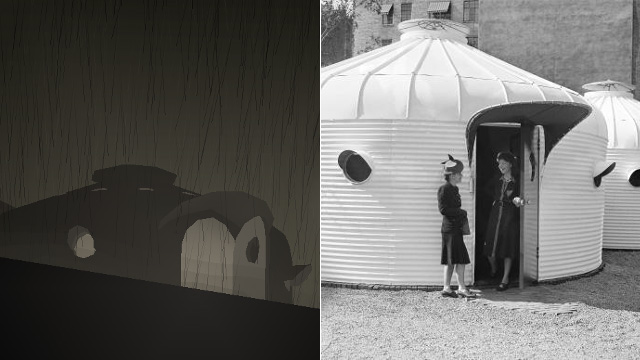
“Let Us Now Praise Famous Men“ was meant to run as a newspaper feature, but was published as a book after being rejected by several editors. Today it is considered a milestone in overcoming established forms of journalism. It deals with three families of farmers in Alabama and fuses detailed factual accounts with sprawling poetry. The photographs Walker Evans took for the book are some of his most widely recognized works. The author, James Agee, went on to become a film critic and director.
Among the tents, trailers and houses in the Museum you can find a so called Dymaxion House. Built by the visionary US architect Richard Buckminster Fuller as a concept case for the home of the future, the Dymaxion House mostly resembles a silo. Fuller’s concept homes were forerunners of today’s energy efficient architecture – though the use of tin certainly wouldn’t pass nowadays – but they were also an answer to the issues of home owners during the Great Depression. The Dymaxion House was an industrial, ready made home, to be constructed on site quickly and efficiently. They never made it into mass production. Only two of them were constructed twenty years after Fuller’s concepts. Today, they are being exhibited in the Ford Museum in Michigan.
Buckminister Fuller’s Dymaxion ideas, a portmanteu standing for „dynamic maximum tension“, appear in other parts of the episode as well. Driving along Route Zero, the protagonists find a car cemetary full of Dymaxion Cars. These cars are teardrop-shaped, three-wheeled busses, designed for energy and fuel efficiency. Like in David Lynch’s films, the world of Kentucky Route Zero exists in a blend between the 1950s and the present. In this world, Fuller’s failed concepts seem to stand for the loss of an almost tangible future. Today, we’re just as far away from resolving the issues of the past.
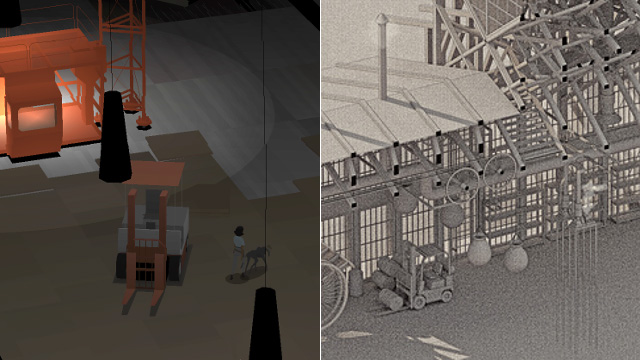
The Great Recession
Visually, the „Museum of Dwellings“ borrows liberally from Retrofitting The American Dream, a design study by Artur Nestrenko. His work deals with finding inventive solutions to the predictions of socio-geographic changes due to the global recession: The Post-WWII urban spaces of the US are based around mobility and the needs of commuters. In times of peak oil and a lack of natural resources, these urban spaces cannot be supported any longer. A suburban mass exodus is inevitable — or so the theory says. Some see proof for that in suburbs that have been ravaged by mass foreclosures after the financial crisis and the burst of the real estate bubble.
This is the starting point for Nestrenko’s work. The empty structures of suburbia should not be destroyed, but re-used for new spaces in an inventive way. This sort of visual reference fosters the previously discussed theme of finding new uses for old habitats, like transforming office spaces into churches and offices into stages.
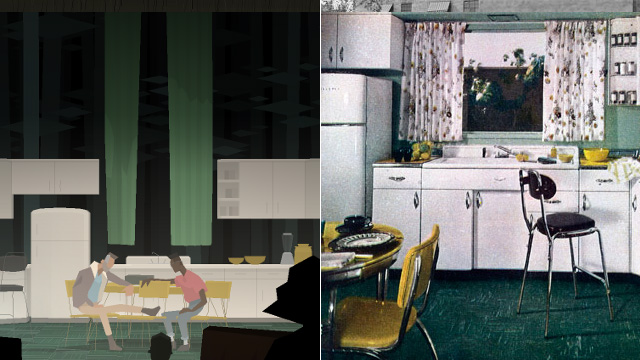
There are traces of the economic crisis in other scenes of the game as well. A doctor tells us about his excessive study loan and medical patents while we visit his idealized 1950s dream home. His name, Dr.Truman, is reference to the eponymous President of the United States of America, whose Fair Deal included the failed attempt at introducing a universal health care insurance.
Perspectives
Parallaxes are what I would like to examine last. Parallaxes are perceived changes in an object when it is looked at from different perspectives. The most common example is our human eye, which provides us with two different images to enable spatial perception.
Parallaxes appear not only as a part of the inside/outside theme. In Act Two, they are ubiquitous. Parallax scrolling is, without a doubt, what gamers will notice first in the game’s forest scene, which serves as a homage to the paining „Le blanc-seing (carte blanche)” by Belgian surrealist René Magritte. But even the presentation slides in the Bureau include charts explaining parallaxes, while the caretaker’s sermon praises seeing with the left and right eye. There are hints to using parallaxes to measure streets and, finally, we visit some of the first episode’s locations — this time, though, we see them from the perspective of the Route Zero. In a deja vu we can even meet our former self visiting the Elkhorn mine.

In literature, the term parallax was first used in conjunction with James Joyce’s Ulysses, which describes the same situation from the perspective of different characters. Readers thus experience a complete picture of the novel’s plot through a multitude of perspectives. In Act Two, we find a sequence using a similar technique when the textual and gameplay layer are shown from two different perspectives. While Conway and Shannon search the Museum for Dr.Truman, we read how the museum staff discusses this incident at some point after the protagonists have left.
Adding to that, the developers of Kentucky Route Zero themselves, Cardboard Computer, see a connection between parallaxes and aspects of re-settlement and the reclaiming of spaces.
„For us, this idea of parallax — basically that something can be understood more completely when viewed from two different perspectives alternately/simultaneously — resonates with the issue you identify as ‘relocation’. People are displaced from their homes or places of worship/culture, etc., and then the real tangible & human identity of the place becomes a sort of composite of its former role as a site of life/worship/culture/etc. & its current role as a site of oppression or as a space that tries to be anonymous but still echoes an oppressive trauma.“
Conclusion
Act Two focuses on architecture, philosophy and different perspectives on questions of migration and socio-cultural issues of home. Like in the first episode, there are numerous other themes to discuss: I could go on and on about the true nature of the subterranean Route Zero, the meteorite impact or philosophize about the role of age, youth and health. And I didn’t even touch upon the symbolism of animals and nature prevalent in Act Two. So, maybe next time.
For everybody who’s just too anxious to wait: There’s Daniel Winter’s Twine-based Kentucky Fan Fiction On the Road and you should play it.
Guest author Magnus has neither a Facebook nor a Twitter, but on Wednesday mornings you just might run into him at the Stadtbad Schöneberg in Berlin.